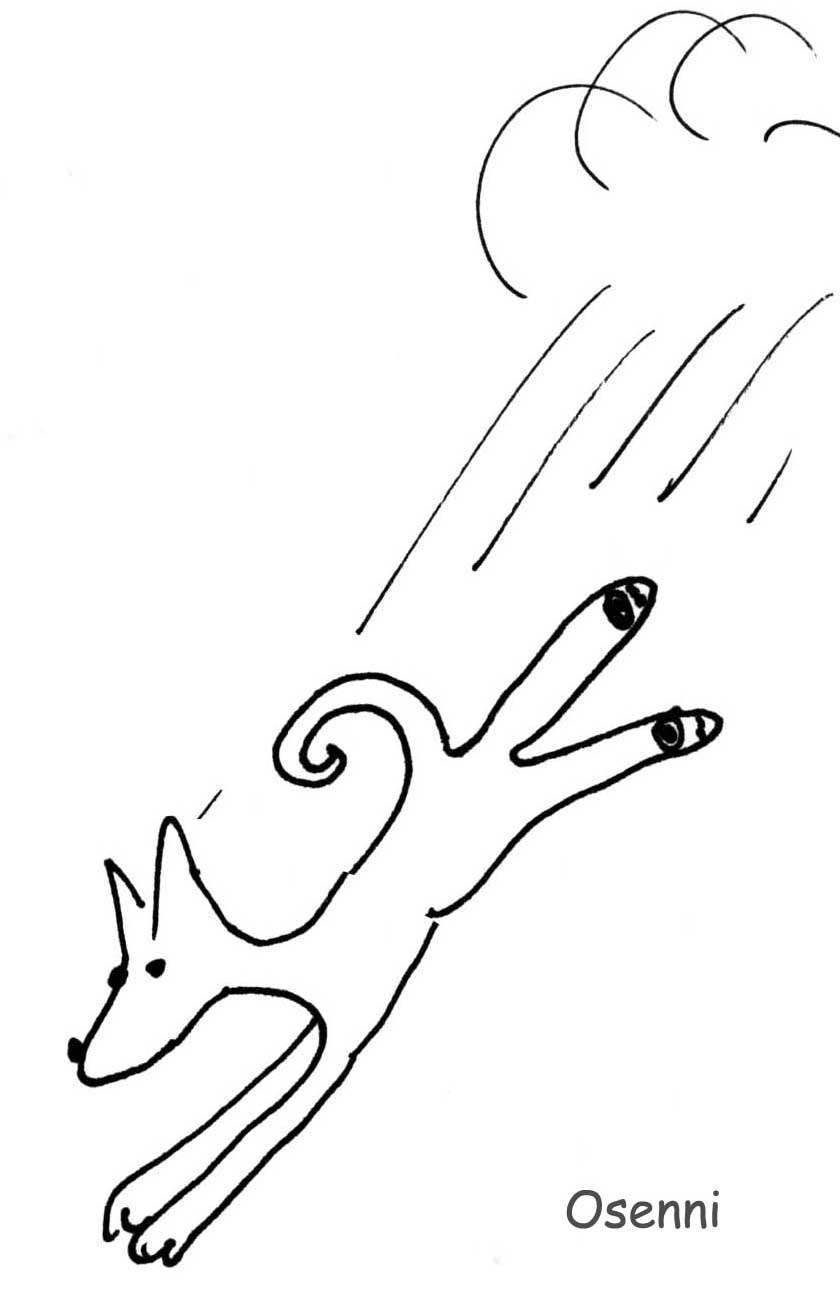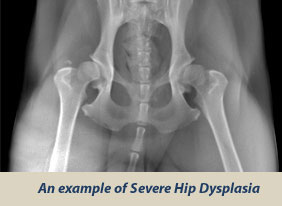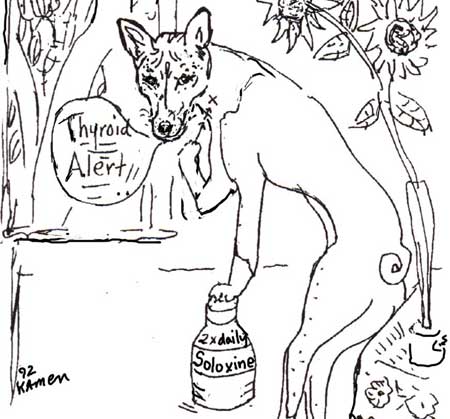Page 15 <previous page > <next page>
SOME HEALTH & SCIENCE NEWS

Certainly we've come a long way from urine strip testing to cheek swabs! And, some of us remember sending blood samples with frozen beer cans down to Russell Brown to "test" for HA. We remember the time when no one x-rayed basenjis for hip dysplasia, or tested patellas. We remember when we changed the CERF status so basenjis with certain types of PPMs could pass. I remember when thryoid testing was a mystery, or just never done. We remember when heart murmurs & cistinuria were not thought about.
Gratefully, we have tools now, and everyone needs to use these tools.
See Health INFO on the BCOA site.
You can prepay a DNA swab kit to test for fanconi at the OFA site.
There is no excuse for not x-raying hips before breeding either a dog or bitch. It is a tool we have. My vet says that a tiny bit of anesthesia is a small thing compared to the scourge of hip dysplasia. And, yes, there are basenjis who have hip dyplasia. The numbers are skewed, as it is still possible to send films in without signing the release on the form, so that only good results are shown. Once again, you can read about hip dysplasia at the OFA site.
WHAT IS HIP DYSPLASIA?

Hip Dysplasia is a terrible genetic disease because of the various degrees of arthritis (also called degenerative joint disease, arthrosis, osteoarthrosis) it can eventually produce, leading to pain and debilitation.
The very first step in the development of arthritis is articular cartilage (the type of cartilage lining the joint) damage due to the inherited bad biomechanics of an abnormally developed hip joint. Traumatic articular fracture through the joint surface is another way cartilage is damaged. With cartilage damage, lots of degradative enzymes are released into the joint. These enzymes degrade and decrease the synthesis of important constituent molecules that form hyaline cartilage called proteoglycans. This causes the cartilage to lose its thickness and elasticity, which are important in absorbing mechanical loads placed across the joint during movement. Eventually, more debris and enzymes spill into the joint fluid and destroy molecules called glycosaminoglycan and hyaluronate which are important precursors that form the cartilage proteoglycans. The joint's lubrication and ability to block inflammatory cells are lost and the debris-tainted joint fluid loses its ability to properly nourish the cartilage through impairment of nutrient-waste exchange across the joint cartilage cells. The damage then spreads to the synovial membrane lining the joint capsule and more degradative enzymes and inflammatory cells stream into the joint. Full thickness loss of cartilage allows the synovial fluid to contact nerve endings in the subchondral bone, resulting in pain. In an attempt to stabilize the joint to decrease the pain, the animal's body produces new bone at the edges of the joint surface, joint capsule, ligament and muscle attachments (bone spurs). The joint capsule also eventually thickens and the joint's range of motion decreases.
No one can predict when or even if a dysplastic dog will start showing clinical signs of lameness due to pain. There are multiple environmental factors such as caloric intake, level of exercise, and weather that can affect the severity of clinical signs and phenotypic expression (radiographic changes). There is no rhyme or reason to the severity of radiographic changes correlated with the clinical findings. There are a number of dysplastic dogs with severe arthritis that run, jump, and play as if nothing is wrong and some dogs with barely any arthritic radiographic changes that are severely lame.
Once you are at the OFA site, you can use the SEARCH tool on the left to see
just which basenjis have been tested, and for what, and those results.
It is foolish to breed a dog or bitch without a complete thyroid panel in the anestrus before the breeding.
My 1992 drawing has to be amended, as Soloxine is no longer an approved drug; see below.

FDA Issues Warning Letters to Manufacturers of Unapproved Levothyroxine Drugs for Hypothyroidism in Dogs
FDA
U.S. Food and Drug Administration
Protecting and Promoting Your Health
January 29, 2016
The U.S. Food and Drug Administration has issued warning letters to six manufacturers of unapproved levothyroxine sodium drugs for hypothyroidism in dogs. These unapproved products have not been reviewed by the FDA for safety and effectiveness.
Thyro-Tabs Canine (levothyroxine sodium tablets), (NADA 141-448) is the only FDA-approved drug for replacement therapy for diminished thyroid function (commonly known as hypothyroidism) in dogs.
FDA is concerned about unapproved animal drugs. Animal drugs that have not been reviewed and approved by FDA may not meet FDA’s strict standards for safety and effectiveness. They also may not be properly manufactured or labeled.
FDA issued warning letters to manufacturers of the following unapproved levothyroxine products:
Thyrosyn
Soloxine
Levocrine
Thyromed
Thyroid Chewable Tablets
Thyrokare
Thyroxine L
Thyrovet
Leventa
If the companies that were issued the warning letters continue to market the violative products, they may be subject to enforcement action, including seizure of violative products and/or an injunction.
Shipments of levothyroxine active pharmaceutical ingredient (API) not referenced in an approved animal drug application or the subject of an index listing or a valid investigational use exemption and unapproved finished animal drugs containing levothyroxine offered for import may be subject to refusal.
Dog owners and veterinarians can report to the FDA any adverse events, including ineffectiveness, in dogs that received approved or unapproved hypothyroidism products. Information on reporting adverse events can be found at: http://www.fda.gov/animalveterinary/safetyhealth/reportaproblem/ucm055305.htm.
Warning Letters
Neogen Corporation
Quality Animal Care Manufacturing
Virbac Animal Health, Inc.
Dechra Veterinary Products LLC
Diamond Animal Health Inc.
Merck Animal Health
Below are two previously published articles; the first on hypothyroidism, the second on IPSID.

Hypothyroidism
in Basenji Dogs
by Karen P. Christensen
Since my own dog. Selket, was diagnosed with hypothyroidism (HT), I have had some time to research the symptoms of the disease. I have become something of a crusader, suggesting thyroid testing to dog owners for symptoms ranging from weight gain to seizures to infertility: the overweight, 4 year-old golden retriever (HT is very common in Goldens) at the kennel, who was having seizures; a friend whose year-old basenji is losing the fur from her puppy buns; the woman in the dog park with the greyhound (another high-HT breed) whose skin was callused, greasy and smelly, like Selket's; the couple at the vet whose 2 year-old lab is so overweight you could serve dinner on his back....
The reasons for this are simple:
The literature indicates that Hypothroidism is the most common endocrine disorder in dogs, and we know, for people, Synthroid is the third most used pharmaceutical in the USA. All of the above symptoms can be related to hypothyroidism.Using the proper tests, HT is relatively easy and inexpensive to diagnose. HT is extremely easy to treat with daily replacement therapy; and Treatment makes such a huge difference in the quality of life for the dog and therefore for its owner.
The case for regular thyroid screening for all dogs is easy to make. While treating a HT dog is not difficult, it is not a characteristic anyone would want to encourage in breeding, and which needs to be understood in breeding stock. Hypothyroidism in basenjis has shown up in dogs as young as 12 months old.
A lack of thyroid hormone can cause a vast array of symptoms that are also common to other illnesses. Thyroid screening can thus be used to rule out hypothyroidism as the cause of some symptoms, as well as ruling it in. Many of the conditions, such as weight gain, lethargy, and joint problems, when seen in older dogs, are considered unavoidable symptoms of age. I considered Selket an old dog at 8 years, due to her lack of energy, thick skin, and lameness in her shoulder; at 11 years, I do not consider her old at all as I watch her romp with a much younger dog. The difference has been the diagnosis and treatment of hypothyroidism.
The reason for the symptoms is that thyroid hormones control metabolism of fats, carbo-hydrates and lipids; energy transfer; and cell maturation. This last is the cause of poorskin/coat quality, joint problems (cartilage does not regrow fast enough to replace what is worn off), and sterility (sperm and eggs do not mature.) Because lipids are not metabolized, a hypothyroid dog may have high cholesterol, which can cause seizures and heart problems due to plaques in the coronary arteries (atherosclerosis, the same cause of heart disease as in humans), as well as strokes.
The thyroid hormones regulate metabolism.
The high cholesterol that accompanies hypothyroidism (too little thyroid hormone) can, however, lead to atherosclerosis and strokes in dogs.
Thyroid function tests are affected by many things, including stress and medications. Several recent studies have demonstrated that phenobarbital therapy causes falsely low values on some thyroid tests. Recent seizures will also cause false lowering of the values, presumably due to the stress they cause. So test results need to be interpreted with these caveats in mind. If an animal tests truly low on thyroid function, then a trial of thyroid supplementation is indicated.
The blood serum sample from a hypothyroid dog may look like a strawberry milkshake - cloudy, thick, and bright pink. This is from the lipemia/high cholesterol and from hemolysis. I was pretty shocked and upset when I saw this in Selket's second sample (after a month on a low dose of levothyroxin, the synthetic thyroid replacement normally prescribed), since I expected a clear, pale yellow liquid. When I spoke to Dr Dodds (see below) she said this was a strong indication of hypothyroidism (which makes me wonder why we even had the sample analyzed instead of just upping the dose). Literature indicates the presence of high cholesterol makes measurement of one form of thyroid, T3, inaccurate for diagnosing hypothyroidism.
Monitoring your dogs:
Of course it is preferable to diagnose hypothyroidism before the dog becomes ill. Since it is relatively common in basenjis, it is not unreasonable to begin annual testing, as Wellness Care, after puberty. Testing must be done in anestrus, which means count 100 days from the first day of the heat cycle.
By the way, you should do the same for male dogs who are around bitches in season.
It is very important to have the right thyroid tests done.
I use Dr. Dodds (Hemopet Thyroid Testing) because she gives her opinion along with the test results. Since Hemopet is Not-for-Profit, the fee is quite reasonable. You can choose to have a complete panel + the OFA panel done. Jean knows the correct levels for basenjis, which she says is different from other sighthounds and other breeds.
And you can talk to her. You SHOULD talk to her, if you suspect your dog is hypothyroid, if you have results from a different lab, or if your vet gives you a hard time. Email her or give call her at Hemopet.
Total T4 or T3 measurement alone, or T3 & T4 alone, are not accurate for diagnosing HT. You need to have results for T3, T4, Free T3, Free T4, and TgAA. TSH levels are not particularly useful (65% predictive in canines).
Treating the hypothyroid dog is inexpensive and easy. They simply get a small pill twice a day of levothyroxine (T4 - Thyro-Tabs).
The pill should be given 1 hour before or 3 hours after meals, and not in milk products.
Peanut butter or steamed yams work fine to hide the tiny pills.
Finally, I have heard of some people who are reluctant to use thyroid replacement because it is synthetic, because it is a pharmaceutical, a drug. Well, it is a chemical the dog normally has. There is no herbal equivalent for synthetic levothyroxine. The synthetic drug contains only the T4 and no other biologically active molecules.
As for the drug companies possibly making money off of us, I'd say they make their profit based on the huge amount that's sold, because the per-dose cost is so low, it cannot be much more than it costs them to manufacture and distribute it.
Here is a list of symptoms of hypothyroidism (that improve when T4 therapy is given); one or more other diseases or conditions could also cause most of them but HT is such a common condition, and is inexpensive and easy enough to test for.
Lethargy,
Mood swings,
Aggression,
Loss of energy,
Vestibular (ear) disease,
Poor coat, scaly skin,
Hypo pigmentation,
Body odor,
Skin lesions,
Weight gain,
Weight loss, picky eater,
Seizures,
Sterility,
Testicular atrophy,
Aspermia,
Absence of heat cycles,
Too many heat cycles,
Prolonged interestrus,
Pseudopregnancy,
Reproductive failure,
Re-absorption of fetus,
Joint problems,
Slow heart rate,
Stiff or slow movement,
Dragging front feet,
Head tilt,
Tragic expression/facial paralysis,
Balance problems,
Frequent vomiting,
Diarrhea,
Cardio-myopathy,
Megaesophagus,
Ruptured knee ligaments,
Corneal ulcers,
Dry eye syndrome,
High cholesterol,
Atherosclerosis,
Cold intolerance,
Heat intolerance,
Exercise intolerance,
Chronic infections,
Anemia,
Low white blood cell count,
Bone marrow failure,
Chronic hepatitis, etc.
IPSID

IPSID stands for immunoproliferative small intestine disease, but it is a disease of many names. It is also called basenji enteropathy, immunoproliferative lymphoplasmacytic enteritis, basenji diarrheal syndrome, and malabsorption. It is one of several different types of inflammatory bowel disease, which result in the dog not being able to utilize and absorb nutrients correctly from food. The human equivalent is Chrons disease.
While IPSID is considered to be inherited, inheritance alone appears to be only one of the factors involved. When genetically normal Basenjiís have food allergies, a viral or bacterial infection and they become sick, at worst, they will come down with inflammatory bowel disease (IBD). With proper medical care they can be cured or maintained for life. A dog genetically pre-disposed to IPSID and its resultant immunicological weakness might start with plain vanilla IBd and eventually progress to IPSID. Stress of a physical or emotional nature also seems to be a factor.
Symptoms can include diarrhea (both large and small bowel), vomiting, weight loss, protein loss, increased or decreased appetite, depression, and gas. The type of symptoms and their severity differ form dog to dog, and from one time to another. Dogs with IPSID often show improvement before the dog again takes a turn for the worst. While some dogs go into remission, they usually relapse and eventually die.
Most of the time vets will use a process of elimination to diagnose IPSID. My vet started out by ruling out giardia. From there, we did a complete blood panel. Everything was normal except the protein levels, which were low. Next, we did a barium x-ray, which showed an enlarged section of the intestine. Last was a biopsy, which is the only reliable way to diagnose IPSID. The biopsy was also done to rule out cancer and systemic fungal infections.
Treatment success is generally limited to improving the quality and length of life. Prednisone is started at 1 mg/kg twice a day to suppress the immune system. Over time the pred can generally be lowered or eliminated until the symptoms resume. However, if the pred is eliminated and restarted it might not be as effective as it was previously. Other drugs that are used are metronidazole, tylosin, and other antibiotics to treat the severe bacterial infections that the dogs are susceptible to. IPSID dogs seem to be a bacterial reservoir, which can cause infections in other household dogs.
The dog's diet is also changed to a hypoallergenic food. A division of Natures Recipe produces prescription diets, venison/potato, rabbit/potato and duck/potato, that work well for IPSID dogs. Dr. Willard of Texas A&M suggests switching diets on a monthly basis to help prevent the intestine from becoming sensitive to what it is being fed can be appropriate. A homemade diet also can be used. Additional vitamin supplementation may be indicated.
Additional references:
1. Cornell University College of Veterinary Medicine Animal Health Newsletter Vol. 10 number 10: Sept. 1996 pgs.3-6.
2. Immunoproliferative Enteropathy of Basenjis By Edward Breitschwerdt, Seminars in Veterinary Medicine & Surgery (small animal), Vol. 7 no 2 (May), pp 153-161.
